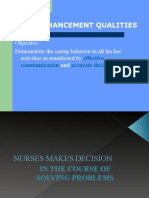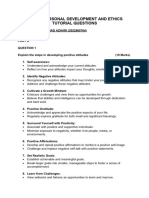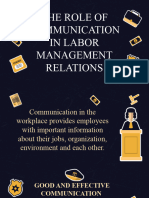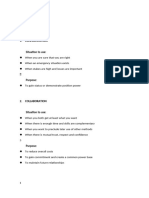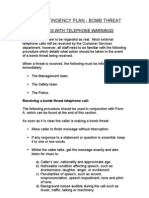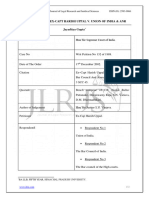0 ratings0% found this document useful (0 votes)
2 viewsFEEDBACK AND DUTY ALLOCATIONPRESENTATION SLIDES
FEEDBACK AND DUTY ALLOCATIONPRESENTATION SLIDES
Uploaded by
mmashauri3Copyright:
© All Rights Reserved
Available Formats
Download as PPTX, PDF, TXT or read online from Scribd
FEEDBACK AND DUTY ALLOCATIONPRESENTATION SLIDES
FEEDBACK AND DUTY ALLOCATIONPRESENTATION SLIDES
Uploaded by
mmashauri30 ratings0% found this document useful (0 votes)
2 views11 pagesCopyright
© © All Rights Reserved
Available Formats
PPTX, PDF, TXT or read online from Scribd
Share this document
Did you find this document useful?
Is this content inappropriate?
Copyright:
© All Rights Reserved
Available Formats
Download as PPTX, PDF, TXT or read online from Scribd
Download as pptx, pdf, or txt
0 ratings0% found this document useful (0 votes)
2 views11 pagesFEEDBACK AND DUTY ALLOCATIONPRESENTATION SLIDES
FEEDBACK AND DUTY ALLOCATIONPRESENTATION SLIDES
Uploaded by
mmashauri3Copyright:
© All Rights Reserved
Available Formats
Download as PPTX, PDF, TXT or read online from Scribd
Download as pptx, pdf, or txt
You are on page 1of 11
FEEDBACK
Feedback is the response of the receiver of the communication, to the
message.
Feedback can be verbal, written, or gestural and comes in various
forms, such as positive, negative, formal, and informal
IMPORTANCE OF FEEDBACK
I. It plays a vital role as it makes communication effective
II. enhance decision-making-it tends to develop an understanding
between the parties concerned
III. It facilitates the evaluation of the effectiveness of the message.
IV. Keeps up the communication process
V. Maintains an open communication climate
CHARACTERISTICS OF EFFECTIVE FEEDBACK
(How to give feedback?)
1.Specific:Effective feedback is always specific and not general.
2. Focus on behavior, not the person: Address the actions or performance
rather than attacking the individual
3. Considers the needs of the feedback receiver:
Feedback should be provided with an intention to help and not to hurt others.
4. Well-timed:
Immediate feedback on any matter is the most useful one
5. Use the "sandwich" approach: Begin with positive feedback or a
compliment, then address areas for improvement, and end with more positive
feedback
6.Be objective and unbiased: Base your feedback on observable facts
and evidence rather than personal opinions or assumptions.
7. Maintain a constructive tone: Use a friendly and professional tone.
Avoid sounding harsh ,it can hinder the effectiveness of your message.
8. Offer suggestions for improvement: Instead of simply pointing out
flaws, provide actionable suggestions on how the individual can
enhance their performance or address the issue at hand.
9. Provide a feedback loop: Encourage the recipient to share their
thoughts, concerns, or questions regarding the feedback
10. Respect confidentiality: If the feedback is sensitive or private,
ensure that you provide it in an appropriate setting and respect the
confidentiality of the conversation.
TYPES OF FEEDBACK
1. Constructive Feedback
-Focuses on providing specific suggestions for improvement while
acknowledging the positive aspects of the individual's performance or
behaviour.
2.Positive Feedback
Highlights the strengths and achievements of an individual or a team.
3. Negative Feedback
Points out the shortcomings or areas where an individual or a team
has not met expectations.
However, it should be delivered carefully and respectfully to avoid
causing resentment or defensiveness.
4. Formal Feedback
Typically occurs within structured settings, such as performance
reviews or evaluations
5. Informal Feedback-
It is more casual and spontaneous during day-to-day interactions
between colleagues or team members
6. Forward Feedback (feedforward)
This focuses on future actions and improvements rather than
dwelling on past mistakes or shortcomings.
Positive Feedforward: An affirmative statement on a person’s
future behavior
Negative Feedforward: A corrective statement on a person’s future
behavior
Points to Remember/Take away
In the case of face-to-face communication, feedback is faster
in comparison to written communication.
It is always directed towards the sender of the message
Feedback could rely upon the exact interpretation of the
message sent or misinterpretation of the message sent.
Non-verbal feedback can be in the form of smiles, sighs,
nods Eetc
verbal feedback takes the form of a reaction to the sender’s
ideas with questions, comments or replies through message
or mail.
ALLOCATION OF WORK(DUTIES IN AN OFFICE)
Work/Duty Allocation
Refers to the process of assigning tasks, responsibilities, and
resources to individuals or teams within an organization
IMPORTANCE OF DUTY OR WORK ALLOCATION
• Optimizes Resources: It ensures that human and other
resources are used efficiently and effectively.
• Improves Productivity: When work is allocated based on
skills and expertise, productivity can be maximized.
• Ensures Timely Completion: Helps in ensuring that
projects and tasks are completed within the stipulated time
frame.
• Employee Satisfaction: Proper allocation can lead to
increased job satisfaction as employees are given tasks that
match their skills and interests.
• Achievement of Goals: Facilitates the achievement of
organizational goals by ensuring that the right people are
working on the right tasks.
• Time management-aids effective time management as
employees know their specific responsibilities
• Accountability-clearly defined duties make it easier to attribute
duties, fostering a sense of accountability among team
members.
• Promotes specialization- allowing employees to focus on
what they do best
What are some common challenges in Work Allocation?
• Resource Constraints: Limited availability of resources to meet the
demands of all tasks.
• Mismatch of Skills: Assigning tasks to individuals who do not have
the appropriate skills or expertise.
• Overallocation: Allocating too many tasks to an individual, leading
to burnout and decreased productivity.
• Poor Communication: Lack of clear communication regarding
expectations and responsibilities.
• Changing Priorities: Shifting organizational priorities that require
reallocation of tasks and resources.
Criteria to consider when allocating duties in an office
1. Employee skills
2. Employee experience
3. Job responsibilities
4. Workload capacity
5. Organizational goals
6. Departmental needs
7. specializations
You might also like
- Roles and Reponsibilities of RCY AdvisersDocument9 pagesRoles and Reponsibilities of RCY AdvisersImelda Dolores Doliente100% (1)
- RA 6713 & RA 9485-BLGF March 31, 2017Document89 pagesRA 6713 & RA 9485-BLGF March 31, 2017Prinston Del CampoNo ratings yet
- Mapeh 7 3RD QuarterDocument3 pagesMapeh 7 3RD QuarterKatty Cedro Dela Cruz100% (2)
- Types of Feedback Ayush Bhai TambeDocument18 pagesTypes of Feedback Ayush Bhai TambeVarun GaikwadNo ratings yet
- LECTURE 06 Feed Back and Giving Constructive FeedbackDocument16 pagesLECTURE 06 Feed Back and Giving Constructive Feedbackwaheed shahzadNo ratings yet
- 009 Giving Receiving Feedback ManagersDocument5 pages009 Giving Receiving Feedback ManagerslavenderbluebloomNo ratings yet
- UNIT-4Document10 pagesUNIT-4Jeru ElbanbuenaNo ratings yet
- Delegation - ManagementDocument8 pagesDelegation - ManagementDianne Ebro100% (1)
- FeedbackDocument6 pagesFeedbackNithya Shree PNo ratings yet
- Feedback From TraineesDocument2 pagesFeedback From Traineesaliffzamriktns200No ratings yet
- People Management, Relation ManagementDocument37 pagesPeople Management, Relation ManagementSam KNo ratings yet
- Manager Interview QuestionsDocument9 pagesManager Interview QuestionsamryoussefkhalilNo ratings yet
- Openness To FeedbackDocument21 pagesOpenness To FeedbackBhavanya RavichandrenNo ratings yet
- ESSP Important Questions-1Document12 pagesESSP Important Questions-1auroshritlenkaal9078No ratings yet
- FeedbackDocument7 pagesFeedbackAneela khanNo ratings yet
- Assessment ModuleDocument3 pagesAssessment ModuleBoom PanesNo ratings yet
- BS English (Presentation and Communication Skills) Notes.Document3 pagesBS English (Presentation and Communication Skills) Notes.skashah17100% (1)
- Unit 5 AssessmentDocument66 pagesUnit 5 AssessmentJasmine Rose VirayNo ratings yet
- The Heart of Managerial ProcessDocument72 pagesThe Heart of Managerial Processmindreader19No ratings yet
- Unit 3 Transactional Communication: Communication StrategiesDocument12 pagesUnit 3 Transactional Communication: Communication StrategiesCielo PulmaNo ratings yet
- Communication May Be Classified Into Several Categories.: Why Is Communication Significant To Management?Document17 pagesCommunication May Be Classified Into Several Categories.: Why Is Communication Significant To Management?ATI BUDGETNo ratings yet
- Area of ImprovementDocument24 pagesArea of ImprovementAbiy KifluNo ratings yet
- Constructive FeedbackDocument5 pagesConstructive FeedbackBerra MkhNo ratings yet
- The Importance of Communication Skills To Your Career1Document2 pagesThe Importance of Communication Skills To Your Career1aytennuraiyevaaNo ratings yet
- Management 101 - 65 ArticlesDocument188 pagesManagement 101 - 65 ArticlesShree SabiNo ratings yet
- Cat Communication SkillsDocument4 pagesCat Communication Skillswswy6kbyn5No ratings yet
- Care Enhancement Qualities: Objective: Demonstrate The Caring Behavior in All His/her Activities As Manifested byDocument41 pagesCare Enhancement Qualities: Objective: Demonstrate The Caring Behavior in All His/her Activities As Manifested byMabelle Guray AcacNo ratings yet
- The Importance of Effective CommunicationDocument5 pagesThe Importance of Effective CommunicationAbhishek GuptaNo ratings yet
- Life Skill EducationDocument15 pagesLife Skill EducationGautham SajuNo ratings yet
- Lesson 4 Leadership CommunicationDocument17 pagesLesson 4 Leadership CommunicationdennissextanchocoNo ratings yet
- X IT Notes Part ADocument19 pagesX IT Notes Part AbharathdinNo ratings yet
- MB0039 Business CommunicationDocument11 pagesMB0039 Business CommunicationKilash JainNo ratings yet
- Intro To CommunicationDocument29 pagesIntro To Communicationanand_89No ratings yet
- DirectingDocument11 pagesDirectingmindreader19No ratings yet
- Performance Management: Supervisor & Employee GuideDocument14 pagesPerformance Management: Supervisor & Employee GuideSarvinay100% (1)
- Feedback in Communication: Prof. Pooja MohantyDocument20 pagesFeedback in Communication: Prof. Pooja MohantyManju EkkaNo ratings yet
- Assignment 2 HMEF5023Document14 pagesAssignment 2 HMEF5023Mohd Razif AzizNo ratings yet
- MGT538 Personal Development and EthicsDocument5 pagesMGT538 Personal Development and Ethicssyifa azhari 3BaNo ratings yet
- of Group 6 in Assessment in Learning 1Document23 pagesof Group 6 in Assessment in Learning 1Angelica CerbitoNo ratings yet
- Business Skills: The Essentials of Leadership, Project Management, and FinanceFrom EverandBusiness Skills: The Essentials of Leadership, Project Management, and FinanceNo ratings yet
- Abhishek 10tha J Feedback in CommunicationDocument19 pagesAbhishek 10tha J Feedback in CommunicationAbhishek KumarNo ratings yet
- Labor FionahDocument27 pagesLabor FionahMARJENEL QUINCE CUNANANNo ratings yet
- HRM AnswerDocument17 pagesHRM AnswerrumuijonatthanNo ratings yet
- Communication Presentation(BOC)Document25 pagesCommunication Presentation(BOC)aryanmittall098No ratings yet
- Unit 4 Communication and Leadership DevelopmentDocument15 pagesUnit 4 Communication and Leadership Developmentaakashtiwari7458No ratings yet
- UNIT-4 Introduction to Management LeadershipDocument16 pagesUNIT-4 Introduction to Management Leadershipkartikchouhan785No ratings yet
- Secretes of Fearless CommunicationDocument56 pagesSecretes of Fearless CommunicationAbhiram P RNo ratings yet
- COMMUNICATION Module 2 220107Document8 pagesCOMMUNICATION Module 2 220107wubeNo ratings yet
- Guide To Performance Review ConversationDocument8 pagesGuide To Performance Review ConversationSHEFALI SHARMANo ratings yet
- Pce ansDocument37 pagesPce ansAqsa KhanNo ratings yet
- Topic 8 Chapter 6 Communication Coaching and Conflict SkillsDocument36 pagesTopic 8 Chapter 6 Communication Coaching and Conflict SkillsLing Meng Cynthia100% (2)
- The Role of Communication in Labor Management Relations ObjectivesDocument8 pagesThe Role of Communication in Labor Management Relations ObjectivesMary Chris del RosarioNo ratings yet
- Ongoing Feedback and Performance ManagementDocument4 pagesOngoing Feedback and Performance Managementmanik_elaNo ratings yet
- Trainees Booklet for Basic CompetenciesDocument13 pagesTrainees Booklet for Basic Competenciesrussel.villegas11No ratings yet
- VinxxDocument3 pagesVinxxVINGKY BUYCONo ratings yet
- FeedbackDocument3 pagesFeedbackabhikchatterjee879No ratings yet
- Topic Workbook - Feedback and Constructive CriticismDocument11 pagesTopic Workbook - Feedback and Constructive CriticismMashiur RahmanNo ratings yet
- GD group discussionDocument3 pagesGD group discussionanshulanuragi80No ratings yet
- Emploability Notes Class XDocument21 pagesEmploability Notes Class Xashumafia2009No ratings yet
- Communication Skills 10Document77 pagesCommunication Skills 10priyanshi.bhardwajNo ratings yet
- Coma 100 - M8Document10 pagesComa 100 - M8Emmanuel D. MalongaNo ratings yet
- Notes Employability Skills CH 1 - Behavioural SkillsDocument13 pagesNotes Employability Skills CH 1 - Behavioural Skillsgavinphotography04No ratings yet
- Business Skills: Project Management, Leadership, and Startup KnowledgeFrom EverandBusiness Skills: Project Management, Leadership, and Startup KnowledgeNo ratings yet
- Ve Part Ii 17-18 PDFDocument11 pagesVe Part Ii 17-18 PDFKushaal SainNo ratings yet
- 13 PitzerKS JSC 13 265 1998Document18 pages13 PitzerKS JSC 13 265 1998buhalnitaNo ratings yet
- Case Digest On Criminal Law IDocument4 pagesCase Digest On Criminal Law IKristine Lara Virata EspirituNo ratings yet
- Ijtihad-A Closer Look From The Modern Perspective: - Presented By: Farhan Riyaz KhanDocument18 pagesIjtihad-A Closer Look From The Modern Perspective: - Presented By: Farhan Riyaz KhanFarhan Khan100% (3)
- GRADES 1 To 12 Daily Lesson Log JUNE 3-7, 2019 (WEEK 1) Monday Tuesday Wednesday Thursday FridayDocument4 pagesGRADES 1 To 12 Daily Lesson Log JUNE 3-7, 2019 (WEEK 1) Monday Tuesday Wednesday Thursday FridayEllah Franzien Dutillos EderNo ratings yet
- DBMS SEM3 CE IT DegreeDocument1 pageDBMS SEM3 CE IT DegreeDhwanil BhattNo ratings yet
- FennelDocument2 pagesFennelAlesam44bNo ratings yet
- Child ExploitationDocument15 pagesChild ExploitationEmi MartiniNo ratings yet
- CollectionDocument16 pagesCollectionPremnath VijayakumarNo ratings yet
- MLE in StataDocument17 pagesMLE in StatavivipaufNo ratings yet
- Chem1031 Study Notes For UNSWDocument37 pagesChem1031 Study Notes For UNSWOliverNo ratings yet
- Precision Power Analyzer: 1 To 8 Channels DC - 10 MHZ Accuracy 0.025 %Document12 pagesPrecision Power Analyzer: 1 To 8 Channels DC - 10 MHZ Accuracy 0.025 %tsampouriseNo ratings yet
- (Smart Animal Production, 2) Ilias Kyriazakis - Smart Livestock Nutrition-Springer (2023)Document337 pages(Smart Animal Production, 2) Ilias Kyriazakis - Smart Livestock Nutrition-Springer (2023)trần quốc vĩNo ratings yet
- Abrahamsson The Robustness of Aptitude Effects in Near-NativeDocument30 pagesAbrahamsson The Robustness of Aptitude Effects in Near-Nativejmlynarczyk21No ratings yet
- Gala National High School: Classroom Observation PlanDocument6 pagesGala National High School: Classroom Observation PlanRizia RagmacNo ratings yet
- Bomb ThreatDocument6 pagesBomb ThreatSentolo LoyoNo ratings yet
- Cat 2009 English Test 103Document3 pagesCat 2009 English Test 103complore100% (1)
- Evidence From The Holy Quran-Oaths in QuranDocument5 pagesEvidence From The Holy Quran-Oaths in Quranz_shan6199No ratings yet
- 3 Sunday After Pentecost: - Dr. Steve PulliamDocument3 pages3 Sunday After Pentecost: - Dr. Steve PulliamKaty PutnamNo ratings yet
- Victorian LiteratureDocument9 pagesVictorian LiteratureShivshankar KumarNo ratings yet
- Rose PetalDocument47 pagesRose Petalzee93% (15)
- Data Collection and PresentationDocument58 pagesData Collection and PresentationArtdel De LugarNo ratings yet
- Jayaditya GuptaDocument6 pagesJayaditya Guptavikrantr963No ratings yet
- Systems ThinkingDocument6 pagesSystems ThinkingMohamed ElkhderNo ratings yet
- Short Audition MonologuesDocument9 pagesShort Audition Monologuesella.godfreyNo ratings yet
- IP-WPWE-85M User ManualDocument27 pagesIP-WPWE-85M User ManualMauro SergioNo ratings yet
- Heneral Luna and GoyoDocument2 pagesHeneral Luna and GoyoejarcegaNo ratings yet


























